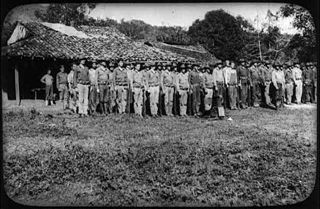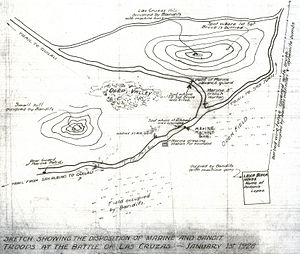Nicaragua is a nation in Central America. It is located about midway between Mexico and Colombia, bordered by Honduras to the north and Costa Rica to the south. Nicaragua ranges from the Caribbean Sea on the nation's east coast, and the Pacific Ocean bordering the west. Nicaragua also possesses a series of islands and cays located in the Caribbean Sea.

Lewis Burwell "Chesty" Puller was a United States Marine Corps officer. Beginning his career fighting guerillas in Haiti and Nicaragua as part of the Banana Wars, he later served with distinction in World War II and the Korean War as a senior officer. By the time of his retirement in 1955, he had reached the rank of lieutenant general.

Augusto C. Sandino, full name Augusto Nicolás Calderón Sandino, was a Nicaraguan revolutionary and leader of a rebellion between 1927 and 1933 against the United States occupation of Nicaragua. Despite being referred to as a "bandit" by the United States government, his exploits made him a hero throughout much of Latin America, where he became a symbol of resistance to American imperialism. Sandino drew units of the United States Marine Corps into an undeclared guerrilla war. The United States troops withdrew from the country in 1933 after overseeing the election and inauguration of President Juan Bautista Sacasa, who had returned from exile.

Nueva Segovia is a department in Nicaragua. It covers an area of 3,491 km2 and has a population of 275,291. The capital is Ocotal.
San Fernando is a municipality in the Nueva Segovia Department of Nicaragua.

The United States occupation of Nicaragua from 1912 to 1933 was part of the Banana Wars, when the U.S. military invaded various Latin American countries from 1898 to 1934. The formal occupation began in 1912, even though there were various other assaults by the U.S. in Nicaragua throughout this period. American military interventions in Nicaragua were designed to stop any other nation except the United States of America from building a Nicaraguan Canal.
Sandinista ideology or Sandinismo is a series of political and economic philosophies instituted by the Nicaraguan Sandinista National Liberation Front throughout the late twentieth century. The ideology and movement acquired its name, image and its military style from Augusto César Sandino, a Nicaraguan revolutionary leader who waged a guerrilla war against the United States Marines and the conservative Somoza National Guards in the early twentieth century. The principals of modern Sandinista ideology were mainly developed by Carlos Fonseca, inspired by the leaders of the Cuban Revolution in the 1950s. It sought to inspire socialist populism among Nicaragua's peasant population. One of these main philosophies involved the institution of an educational system that would free the population from the perceived historical fallacies spread by the ruling Somoza family. By awakening political thought among the people, proponents of Sandinista ideology believed that human resources would be available to not only execute a guerrilla war against the Somoza regime but also build a society resistant to economic and military intervention imposed by foreign entities.

Victor France Bleasdale was a brigadier general in the United States Marine Corps. He was awarded the Navy Cross and Distinguished Service Cross for his actions during the Battle of Blanc Mont Ridge in World War I. Later he received a second Navy Cross for his service at the Battle of San Fernando during the Second Nicaraguan Campaign.

The Battle of Agua Carta, or the Battle of Lindo Lugar, was an engagement between the National Guard of Nicaragua and the rebels of Augusto César Sandino in 1932. It was fought near Mount Kilambe at the Agua Carta, a river in Sandino territory, as part of the American occupation of Nicaragua and a long lasting civil war.

The Battle of Ocotal occurred in July 1927, during the American occupation of Nicaragua. A large force of rebels loyal to Augusto César Sandino attacked the garrison of Ocotal, which was held by a small group of US Marines and Nicaraguan National Guards. Ultimately the rebels were defeated with heavy losses, while the Americans and their Nicaraguan allies suffered very light casualties.

The Battle of Telpaneca was an engagement fought during the United States occupation of Nicaragua in 1927.
The Battle of La Flor was fought in May 1928 between the United States Marines, their Nicaraguan National Guardsmen allies, and a force of Sandinista rebels. It occurred at a hill north of the La Flor coffee plantation and ended with a rebel victory when the Americans and Nicaraguan National Guard troops were forced to withdraw.
The Battle of Achuapa, or the Achuapa massacre, took place on December 31, 1930 during the American occupation of Nicaragua of 1926–1933.
The Battle of La Paz Centro took place on May 16, 1927 during the American occupation of Nicaragua of 1926–1933. It took place after the end of Nicaraguan civil war of 1926–1927 and prior to the Sandino Rebellion of 1927–1933.
The Battle of El Sauce, or the Battle of Punta de Rieles or Punta Rieles, took place on the 26 December 1932 during the American occupation of Nicaragua of 1926–1933. It was the last major battle of the Sandino Rebellion of 1927–1933. The incident has its origins in Nicaraguan President José María Moncada's plan to commemorate the completion of the León–El Sauce railway on 28 December 1932.
The Nicaraguan Civil War of 1926–1927, or the Constitutionalist War, broke out after a coup d'état by Emiliano Chamorro, a member of the Conservative Party, removed Nicaragua's democratically elected government, resulting in a rebellion by members of the Liberal Party. The conflict came to an end after a military and diplomatic intervention by the United States resulted in the Pact of Espino Negro, which began the Peace of Tipitapa. Although the civil war came to an end, one Liberal general, Augusto César Sandino, refused to lay down his arms and waged the Sandino Rebellion against the Nicaraguan government and the US Marine Corps until 1933.
The Battle of San Fernando took place on July 25, 1927 during the American occupation of Nicaragua of 1926–1933. Shortly after the Battle of Ocotal, an expedition of seventy-eight American Marines and thirty-seven Nicaraguan Provisional Guardsmen led by Major Oliver Floyd were sent hunting for rebel leader Augusto César Sandino. One of their destinations was the town of San Fernando, where Sandino had about forty men waiting for the Marines and their Nicaraguan allies. He placed a sentry outside the village to alert his men of the Marines and Provisional Guard's arrival, but the watchman abandoned his post to be alone with an Indian girl in a nearby shack. The Marines and Nicaraguan government troops marched into San Fernando at 3:00, finding it largely deserted. While galloping across the town's "open, grassy plaza" in order to question an old man, Captain Victor F. Bleasdale and Marine Private Rafael Toro received fire from the waiting Sandinistas, with Toro being mortally wounded. Eventually, the Sandinistas were driven back, leaving eleven of their dead behind. Fighting was over by 3:45. In addition to Marine and Sandinista losses, one woman was wounded in the legs by fire from an automatic weapon.
The Battle of Santa Clara took place on 27 July 1927, during the American occupation of Nicaragua of 1926–1933. After being ambushed by Sandinista forces at the Battle of San Fernando, Major Oliver Floyd's expedition of American Marines and Nicaraguan Provisional Guardsmen continued its advance into enemy-held territory in northern Nicaragua.
The Battle of Sapotillal, or the Battle of Zapotillal or Zapotillo Ridge, took place on the 9 October 1927 during the American occupation of Nicaragua of 1926–1933 and the Sandino Rebellion. The battle was an unsuccessful attempt by American and Nicaraguan government forces to rescue two downed American airmen.
The Battle of El Bramadero, or the Battle of Bromaderos, took place between the 27 and 28 February 1928 during the American occupation of Nicaragua of 1926–1933 and the Sandino Rebellion. The battle began on the twenty-seventh when a convoy of thirty-six Marines, one American naval pharmacist's mate, twenty Nicaraguan "muleros," two Nicaraguan "'Jefe' muleros," and 99 mules led by First Lieutenant Edward F. O'Day moving along the Yalí–Condega trail was ambushed by a force of Sandinista rebels led by Miguel Angel Ortez.








